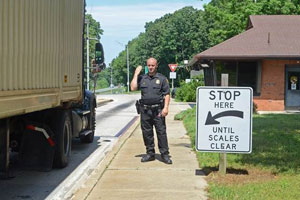CVSA International Roadcheck Gets Underway

WEST FRIENDSHIP, Md. — Jose Andrade has had better days than June 7. The driver for Dairy Maid Dairy of Frederick, Maryland, was behind the wheel of the truck that was inspected for the media as part of the Commercial Vehicle Safety Alliance’s 29th annual International Roadcheck.
While tire safety is the focus of this year’s three-day event, Andrade’s aging International truck was taken out of service for worn and chafing air lines and for failure to maintain proper air pressure.
Although Andrade has been driving on the road in Maryland for two years after almost eight as a yard jack, the inspection was his first.
“I’m not really upset because it’s a safety hazard, I guess,” Andrade said as he began the wait for a mechanic to arrive at the weigh station on Interstate 70 after he had called his supervisor with the bad news. “I’d rather go out of service than have an accident.”
Which is the whole idea behind commercial vehicle inspections and Roadcheck.
“International Roadcheck is a snapshot of what the 13,000 CVSA-certified road side inspectors across North America do every day, 4 million times a year,” CVSA Executive Director Collin Mooney said in kicking off the event.
Robert Molloy, director of the Office of Highway Safety of the National Transportation Safety Board, investigates crashes involving large trucks that take nearly 4,000 lives annually.
“Every inspection done is an opportunity to improve safety,” Molloy said. “Wouldn’t it be great if unsafe vehicles and unsafe drivers were off the road before they had the crash? My challenge to all the inspectors participating in the event is simple: Put me out of business.”
Scott Darling, acting administrator of the Federal Motor Carrier Safety Administration, said, "Safe trucking moves the economy" as trucks rumbled behind him.
As Darling noted, tires are the No. 2 cause of truck safety violations nationwide and No. 1 in Maryland, but those on Andrade’s truck passed muster with Robert Hobbs, L.V. Brown and Jerome Anthony of the Maryland State Police. The same could not be said of some other parts of the vehicle during the Level I Inspection, the most thorough version conducted in North America.
During the 37-step procedure, drivers are asked to provide their license, endorsements and hours-of-service documentation, and they are checked for seat belt usage and any apparent impairment by alcohol and/or drugs.
The trucks are then inspected from front to back, top to bottom. Hobbs and Co. took about 45 minutes to examine the braking system, cargo securement, coupling devices, exhaust systems, frames, fuel systems, driveline/driveshaft components, lights, steering mechanisms, suspensions, tires, van and open-top trailer bodies, wheels, rims and hubs, and windshield wipers of Andrade’s truck.
“It’s an older truck, late '90s, maybe 2000,” Hobbs said as he stood in a narrow but long pit underneath it. “It’s definitely seen some wear and tear.”
While recognizing the importance of tires, Anthony said a good one can cover for a poor one in a dual set. On the other hand, he and Hobbs cited faulty drive shafts falling off trucks as the most dramatic violations they’ve seen.
“Prior to that, it’s not even a violation,” Hobbs said. “We try the best we can to let these drivers know — and hopefully they’ll let their mechanics know — that it looks close [to being put out of service].”
Hobbs said the inspection process works well on Maryland highways. However, he lamented that in more urban areas, such as Baltimore, there are so many trucks that never get inspected because they don’t visit weigh stations and have been able to avoid the state’s handful of roving inspectors.

